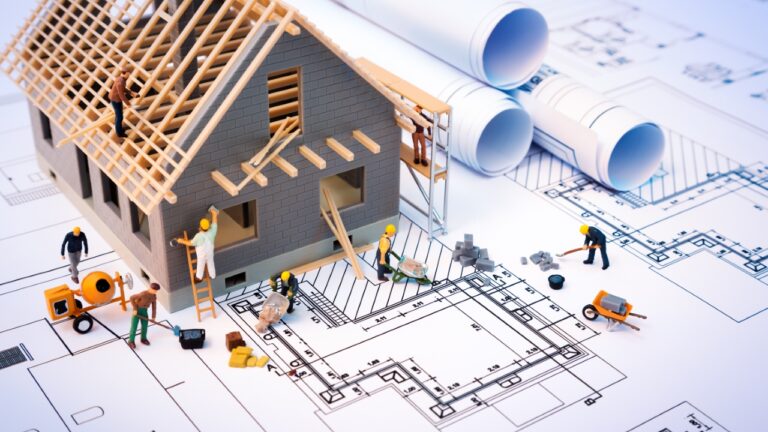For most homeowners, embarking on the construction or renovation process can be a daunting experience due to the unfamiliarity of construction terminology. Whether you’re updating your kitchen or adding an entire new wing to your house, you’ll soon realize how important it is to speak the language of the building. This will help you read contracts, manage your budget and communicate with your team of contractors and designers. Informed homeowners are happier with the end result because they’ve been part of the decision-making and oversight process.
In this article, we’ll explore common construction terms that come up in home improvement projects. We’ll explain why they matter, how they fit into the overall construction process, and how Bolster supports homeowners from planning to completion.
Terms to Know
- Subcontractor
A subcontractor is a specialist hired by the General Contractor to do a specific part of the work, such as plumbing, electrical or roofing. While the GC is in charge of the whole project, subcontractors bring specialized skills. This structure ensures high-quality workmanship across all disciplines, but it also means coordination is key to avoiding scheduling conflicts. - R-Value
R-Value measures how well a material resists heat flow. Insulation materials have different R-Values depending on thickness and density. A higher R-value means better insulation, which means lower energy bills and greater indoor comfort. This is especially important in areas with extreme seasonal temperature swings. - Footings
Footings are the concrete bases under the foundation. They distribute the weight of the structure evenly on the soil so it doesn’t settle unevenly or cause structural damage. Without proper footings, even the sturdiest materials can shift over time and cause cracks in walls and floors. - Framing
Framing is the skeleton of the house, typically made of lumber or steel. This is where walls, floors and roofs take shape. Proper framing is critical to structural integrity; any mistakes at this stage can cause a multitude of problems, from uneven floors to unsafe living conditions. - Change Order
A Change Order is an official document that changes the original scope of work, budget or schedule. Changes can come from unexpected site conditions, design changes or material shortages. Knowing how change orders work helps homeowners anticipate cost or timing changes.
Why These Terms Matter to Homeowners
Being fluent in these construction terms isn’t just about sounding smart. These concepts impact your project’s outcome. For example, misunderstanding the R-value of your insulation could mean a house that’s not energy efficient and higher utility bills. Overlooking footings in the initial planning phase could mean uneven settling down the line and costly repairs.
Each term also comes into play in contract negotiation and project management. Knowing the difference between a subcontractor and a general contractor, for example, means who’s responsible for what. This awareness helps you set more realistic expectations and better communication—the foundation of a successful renovation.
How Bolster Supports Homeowners
At Bolster, we believe an informed homeowner is our best partner for success. That’s why we prioritize clear communication and explanations throughout the project.
- Pre-Construction Consultations: We take the time to walk you through the scope and design of your project. We explain each step from footings to finishes so you know what to expect.
- Budget Clarity: Construction projects change and change orders will happen. Bolster addresses these changes proactively so you know the cost impact before you approve.
- Quality Control: Our subcontractors are thoroughly vetted for quality and skill. We monitor all work to ensure each job is done to perfection. Whether it’s a new addition framing or a complex electrical install, every step is double checked.
- Post-Project Support: Our relationship doesn’t end after the final walk-through. We offer follow-up support to address any issues or minor tweaks so you’re happy long-term.
Homeowner Tips for Construction Terms
- Get a Written Breakdown
Ask your contractor or project manager for a written breakdown of tasks and terminology. Having this in writing helps you follow along as each phase happens. - Use Visuals
If you’re having trouble understanding certain concepts—like how framing ties into the overall structure—ask for diagrams or 3D models. Visuals can help clarify complex ideas and make it easier to see how each piece fits into the whole. - Schedule Site Walks
During the construction process, schedule walks with your contractor. Seeing the project in person helps you understand terms like footings, framing and change orders. It also allows you to ask questions about any surprises that come up. - Keep a Change Log
If changes happen—like switching from one type of insulation to another—document why the change happened, who approved it and how it impacts your budget or schedule. This will be golden if disputes or questions come up later.
Bottom Line
Renovating or building can be one of the most fun times for a homeowner. But without a good understanding of construction terms, it can be overwhelming. By knowing the basics like subcontractors, R-values, footings and change orders, you’ll feel more comfortable and in control from day one.
Working with Bolster elevates the experience. We prioritize clear communication, so even the most technical construction terms are explained in plain language. Our goal is to empower you, the homeowner, to make smart decisions that result in a beautiful, functional and lasting outcome.
Pro Tip: Don’t be afraid to ask “why?” at any point. “Why is this material better?” “Why does this phase take longer?” Curiosity breeds collaboration and allows you and your contractor to work together more effectively. When it comes to home construction or renovation, smart decisions = a home that’s right for you, your lifestyle and your budget.
For more information, check out this blog on “92 construction terms everyone should understand.”
